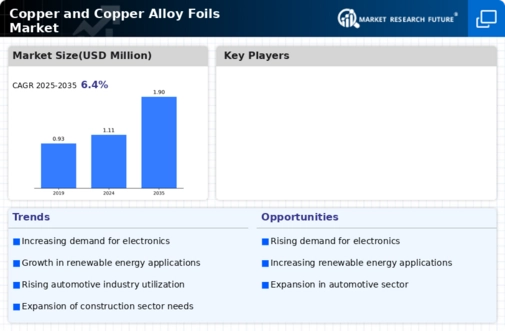Market Trends
Key Emerging Trends in the Copper Alloy Foils Industry
In the ever-evolving landscape of the global bronze market, transformative trends are playing a pivotal role in shaping its trajectory. This research report aims to illuminate the key trends that are redefining the industry, offering stakeholders crucial insights into the current dynamics and future possibilities within the bronze market.
Advancements in Bronze Alloys: At the forefront of industry trends is the continuous evolution of bronze alloys. Alloy compositions such as aluminum bronze, phosphor bronze, silicon bronze, and manganese bronze are undergoing refinements to meet the evolving demands of diverse applications. The research and development efforts in this area aim to enhance mechanical properties, corrosion resistance, and machinability, driving innovation and expanding the scope of bronze applications.
Manufacturers are investing in creating alloys that not only retain the classic characteristics of bronze but also offer improved performance, opening up new avenues across industries. This trend reflects a commitment to staying at the forefront of materials science and adapting bronze to meet the increasingly sophisticated needs of modern applications.
Sustainability and Eco-Friendly Practices: The global shift towards sustainability is influencing material choices across industries, and the bronze market is no exception. Bronze's recyclability and durability are positioning it as a sustainable alternative to traditional materials. This trend aligns with the growing emphasis on eco-friendly manufacturing practices, prompting industry players to adopt responsible approaches in the production and application of bronze.
As environmental consciousness continues to gain prominence, bronze's inherent sustainability becomes a key selling point. Stakeholders in the bronze market are increasingly recognizing the importance of eco-friendly practices in meeting market demands and ensuring long-term viability.
Rising Demand in Aerospace Applications: The aerospace sector is witnessing a surge in demand for bronze, particularly aluminum bronze. This trend is propelled by the aerospace industry's quest for lightweight yet robust materials. Aluminum bronze's exceptional properties, including high strength, corrosion resistance, and durability, make it a preferred choice for critical components in aircraft and spacecraft manufacturing.
As technological advancements drive innovation in the aerospace sector, the demand for bronze is expected to escalate. Manufacturers are strategically positioning themselves to cater to this growing demand, capitalizing on the unique properties of bronze that align with the stringent requirements of aerospace applications.
Marine Engineering Applications: The marine industry has long been a stronghold for bronze, and current trends indicate a sustained and growing demand. Bronze's resistance to corrosion, particularly in harsh saltwater environments, positions it as an ideal material for marine hardware, shipbuilding, and offshore structures.
As the maritime sector places increasing importance on durability and longevity, bronze remains a critical component in addressing these requirements. The demand for bronze in marine engineering applications is expected to remain robust, driven by ongoing developments in the shipping and offshore industries.
Technological Integration in Autonomous Ships: The integration of technology, particularly in the form of autonomous ships, is an emerging trend with significant implications for the bronze market. As the maritime industry embraces autonomous technologies, bronze components play a crucial role in ensuring the reliability and efficiency of critical systems.
Bronze's properties, including corrosion resistance and durability, make it a suitable choice for manufacturing sensors, valves, and various marine components crucial to the success of autonomous vessels. This trend positions bronze as a material of choice in the future of marine transportation.
Infrastructure Development and Construction Boom: The global surge in infrastructure development and construction projects is influencing the bronze market. Bronze's resilience, anti-corrosive properties, and longevity make it a material of choice in construction applications, from architectural elements to structural components.
As urbanization and infrastructure development continue to drive construction projects worldwide, bronze's diverse applications in this sector contribute to its sustained demand. This trend highlights the adaptability of bronze in meeting the challenges posed by large-scale construction endeavors.
Conclusion:
In conclusion, the global bronze market is undergoing a transformative phase propelled by multifaceted trends. From advancements in alloy compositions to a growing emphasis on sustainability, the bronze market is evolving to meet the diverse demands of modern applications. This research report serves as a comprehensive guide for stakeholders, offering a nuanced understanding of the current dynamics and future possibilities within the dynamic landscape of the global bronze market.
As these trends continue to unfold, the bronze market is poised for sustained growth and innovation, marking a compelling journey into the future of materials science and applications. Stakeholders who navigate and leverage these trends effectively will be well-positioned to contribute to and benefit from the ongoing evolution of the global bronze market.



Leave a Comment